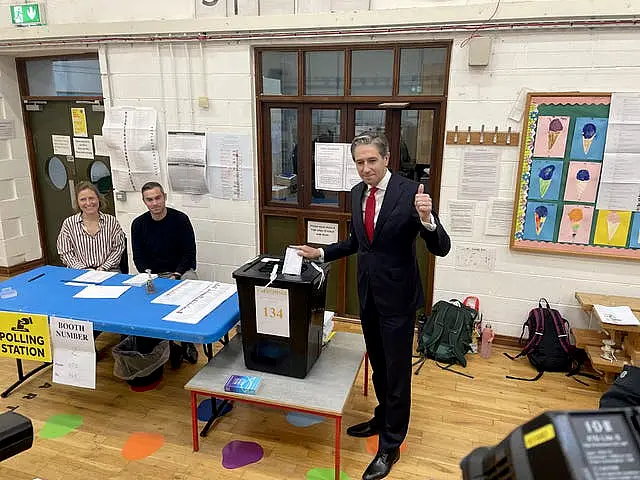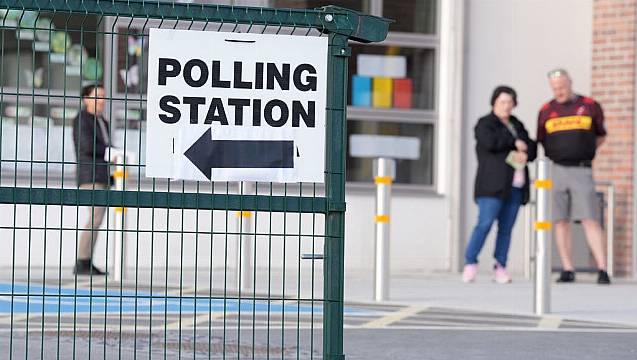Polling stations have closed after voters cast their ballots in three elections. Voter turnout averaged 41.91 per cent across Dublin.
Coming up to 9pm in the Artane Whitehall area turnout was at 49.46 per cent, Ballyfermot Drimnagh at 42.05 per cent, in Ballymun Finglas at 30.54, and in Clontarf at 48 per cent.
Donaghmede was on 49 per cent turnout, Kimmage Rathmines was 39 per cent, and the south-west inner city at 38 per cent.
Voter turnout for Cork county was averaging 26.8 per cent at 5pm, but this had increased to 43.4 per cent by 8pm. This was higher than the 42.2 per cent recorded in 2019. However, polling stations were recording large differences ranging 32 per cent in some parts of the county to 53%.
Kerry was expected to hit 50 per cent by the time polls closed at 10pm, while Dungarvan in Co Waterford had already gone over 50 per cent with more than an hour left in voting.
Votes were cast for local authorities, the European Parliament and for the first time voters in Limerick are directly electing a mayor.
Ballot boxes will be opened at 9am on Saturday before counting in the local elections get under way later in the day.
The counting of votes in the European election will start on Sunday while the mayoral votes will be counted on Monday.
On Friday evening, there were reports of a steady turnout of voters.
Party leaders including Taoiseach Simon Harris led the way in casting their votes on Friday morning.
Mr Harris urged everybody to “get out and have their say”.
The separate elections come at a febrile time in Irish politics dominated by discussion on a housing crisis, the cost of living and migration.
The coalition partnership of Fine Gael, Fianna Fáil and the Green Party has been battling criticism domestically and on the continent over other issues including climate action, agriculture policy and defence co-operation in the EU.
The eagerly awaited polls will provide political parties with concrete evidence of voter sentiment, having had to wait more than four years since the last nationwide elections.
Support for Sinn Féin has hovered above 30% for a long time – even temporarily reaching highs of around 35%. However, opinion polls over the last eight months suggest that support for the party is on a dramatic slide as independents eat up more of the expected vote share.
Many of the ballot papers across the elections contain a large number of independents with a variety of political leanings, several of whom have been described as anti-immigrant.
Also of note, Fine Gael appears to have had somewhat of a “Harris hop” in the polls following the shock resignation of Leo Varadkar as leader of the party earlier this year, leading to Simon Harris taking over.

The results of the three campaigns being decided on Friday may be instructive for the overall state of the parties – and could potentially direct Mr Harris’ decision on when to call the next general election, which must be held by March next year.
President Michael D Higgins and his wife Sabina cast their votes on Friday morning.
The couple were greeted by staff at the polling station in Phoenix Park in Dublin.

Meanwhile, the Taoiseach cast his votes early at Delgany National School in Co Wicklow ahead of a day of campaigning across the country.
“It is so important that people get out and vote, that they have their say, that they cast their ballots because of course if you don’t turn up you’re allowing someone else to speak on your behalf,” Mr Harris told reporters at the voting centre in his home constituency.
“So polls are open to 10pm tonight, I’d urge everybody to get out and have their say in what is a great exercise in democracy.
“We live in a healthy democracy and today is working proof of it.”

Ms McDonald said “today is the big day” and said it was “very important” for people to use their vote.
Speaking after casting her ballot at the polling station on Navan Road in Cabra, Dublin, Ms McDonald denied running too many candidates.
“No, we ran a great slate of candidates and they have all thoroughly enjoyed the campaign and (being) out and about meeting people. So today is the people’s day, please come out and vote,” she said.
In south Dublin, Green Party leader Eamon Ryan said there is no “anti-government sentiment” among the Irish public.
As he cast his votes in Friday’s elections at Muslim School Clonskeagh, Mr Ryan said there was a queue outside the door by 7am.

“This is a Government that’s working and my sense in the last few months canvassing is there isn’t you know … people they recognise the Government is working,” Mr Ryan said.
“They’re not happy with, rightly, a whole range of different things we need to do better.
“But you couldn’t say out there that there’s a strong anti-government sentiment.
“We’ll see if that’s reflected in the count in the end.”
Across the island, millions of residents were eligible to vote in local elections.
There are 31 local government bodies in Ireland. Each county and city council is divided into local electoral areas with a specified number of council seats to be filled in the election.
In total, there are 166 electoral areas in Ireland and each of them elects a number of councillors. The number of councillors to be elected nationally is 949.

These representatives are tasked with making policy decisions at local level including on planning and community development.
The last set of local elections took place in May 2019 against a very different political backdrop. Fianna Fáil won the most council seats overall, the Green Party made historic gains and Sinn Féin lost many of their seats.
This year the three main parties – Fianna Fáil, Fine Gael and Sinn Féin – are fielding a similar number of candidates across every electoral area.
There are also more than 500 independents standing this year, along with dozens of candidates from new parties, such as Independent Ireland and The Irish People.
Below you can find the full list of all 2,171 candidates standing in this year’s election. Use the search bar to find candidates in your area or local authority.
This year has also seen a record number of women standing for election.
There are 682 women running, about 31 per cent of all candidates. There are two local electoral areas where no women are standing – Corca Dhuibhne in Co Kerry, and Moate in Co Westmeath.
In the 2019 local elections, 561 women ran for a seat, while in 2014, 440 women were candidates.
Fianna Fáil comes bottom of the class among the major parties in terms of the number of women running. Only 25 per cent of its candidates are women.
Fine Gael fares slightly better with 29 per cent female candidates.
Sinn Féin is fielding 335 candidates in the local election, 44 per cent of whom are women.
The Social Democrats and the Green Party have an even number of men and women standing as candidates.
Ireland is currently 103rd in the world when it comes to women’s representation in national politics. At the local level, Ireland ranks sixth-last among European Union countries.
At the same time as the local elections, EU citizens registered in Ireland are eligible to vote for 14 Members of the European Parliament (MEPs) across three varied constituencies: Dublin, South, and Midlands-North-West.
Voters in Limerick city and county also have the opportunity to directly elect a mayor. From now on, this vote will also take place every five years.
The successful candidate will be considered the region’s first citizen and will have unique executive powers around long-term strategic planning, including measures on housing delivery, road infrastructure and environmental measures.
They can serve a maximum of two terms, each lasting five years.

There are 15 candidates vying for the new job which carries a salary of approximately €150,000.
The role is seen as a test case for further rollout at other local authorities in the future.
Ballots in the local elections can begin to be sorted straight away on Saturday, but results in the European election cannot be declared until after all EU states have finished polling, which will not happen until late on Sunday night. Counting in the mayoral election is expected to begin on Monday.
However, the entire process may well take several days to complete.







